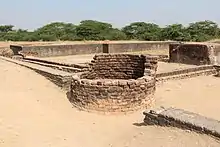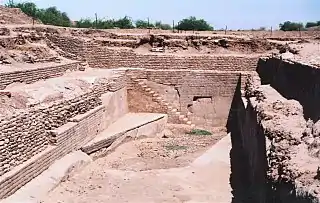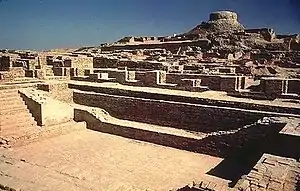Sanitation of the Indus Valley Civilisation
The ancient Indus Valley Civilization of historic India, including current day India and Sindh, Pakistan, was prominent in infrastructure, hydraulic engineering, and had many water supply and sanitation devices that were the first of their kind.


General
Most houses of Indus Valley were made from mud, mud bricks, or clay bricks. The urban areas of the Indus Valley civilization included public and private baths. Sewage was disposed of through underground drains built with precisely laid bricks, and a sophisticated water management system with numerous reservoirs was established. In the drainage systems, drains from houses were connected to wider public drains. Many of the buildings at Mohenjo-Daro had two or more stories. Water from the roof and upper story bathrooms were carried through enclosed terracotta pipes or open chutes that emptied onto the street drains.[1]
The earliest evidence of urban sanitation was seen in Harappa, Mohenjo-daro, and the recently discovered Rakhigarhi. This urban plan included the world's first urban sanitation systems. Within the city, individual homes or groups of homes obtained water from wells. From a room that appears to have been set aside for bathing, wastewater was directed to covered drains, which lined the major streets.
Devices such as shadoofs and sakias were used to lift water to ground level. Ruins like Mohenjo-Daro in Pakistan and Dholavira in Gujarat in India had settlements with some of the ancient world's most sophisticated sewage systems. They included drainage channels, rainwater harvesting, and street ducts.
Stepwells have mainly been used in the Indian subcontinent.
Several courtyard houses had both a washing platform and a dedicated toilet/waste disposal hole. The toilet holes would be flushed by emptying a jar of water, drawn from the house's central well, through a clay brick pipe, and into a shared brick drain, that would feed into an adjacent soak pit (cesspit). The soak pits would be periodically emptied of their solid matter, possibly to be used as fertilizer. Most houses also had private wells. City walls functioned as a barrier against floods.
Mohenjo-daro
Mohenjo-daro, located in Sindh, Pakistan is one of the best excavated and studied settlements from this civilization. The Great Bath might be the first of its kind in the pre-historic period. This ancient town had more than 700 wells, and most houses in Mohenjo-Daro had at least one private well.[2]
Dholavira
Dholavira, located in Gujarat, India, had a series of water storing tanks and step wells, and its water management system has been called "unique".[3] Dholavira had at least five baths, the size of one is comparable with the Great Bath of Mohenjo-daro.[4]
Lothal
The Indus Valley Civilization in Asia shows early evidence of public water supply and sanitation. The system the Indus developed and managed included a number of advanced features. A typical example is the city of Lothal (c. 2350 BCE) in Gujarat, India . In Lothal all houses had their own private toilet which was connected to a covered sewer network constructed of brickwork held together with a gypsum-based mortar that emptied either into the surrounding water bodies or into cesspits, the latter of which were regularly emptied and cleaned.[5][6]
See also
References
- Rodda, J. C., and Ubertini, Lucio (2004). The Basis of Civilization - Water Science? pg 161. International Association of Hydrological Sciences (International Association of Hydrological Sciences Press 2004).
- Singh, Upinder (2008). A history of ancient and early medieval India : from the Stone Age to the 12th century. New Delhi: Pearson Education. pp. 151–155. ISBN 978-81-317-1120-0.
- Singh, Upinder (2008). A history of ancient and early medieval India : from the Stone Age to the 12th century. New Delhi: Pearson Education. p. 155. ISBN 978-81-317-1120-0.
- harappa., com. "Ancient Indus Valley Sites". Harappa.com. Harappa.com. Archived from the original on 2013-06-30. Retrieved 4 July 2012.
- Khan, Saifullah. "1 Chapter 2 Sanitation and wastewater technologies in Harappa/Indus valley civilization ( ca . 2600-1900 BC)". Academia.edu. Academia.edu. Retrieved 9 April 2015.
- "Maya plumbing: First pressurized water feature found in New World". Penn State. May 5, 2010. Retrieved 26 March 2014.
